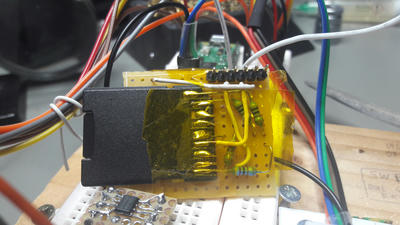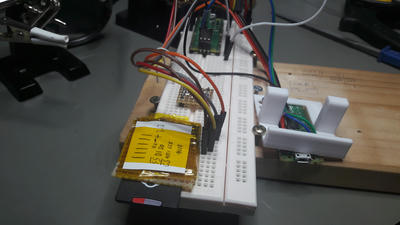Week of Weird Constructions 1
The first week of weird constructions started out with this website and the first post. I'm glad the Zola website generator I use for this website works so good. Especially because it's written in Rust.
HexoTK HexKnob
But now to my projects. I've not yet written an introduction for HexoSynth and I wont do it quite now. Only so much: It's an audio synthesis environment with a certain style. And it's one of my big projects I've been working on in 2021. The GUI had quite some development road behind it. Originally I wrote HexoTK quite simple. But I saw performance problems on the horizon, it ate 20% CPU for basically doing nothing. To fix that I needed to cache the widget output. And then I did something I usually don't do, which is using a library that is not "there yet" with tuix. You can find my so far successful try of implementing the GUI here: HexoSynth tuix GUI
I hoped it would become the future of HexoSynth, but tuix development more or less halted for the new VIZIA. After having too many friction points with the declarative style I decided to go back to HexoTK and I completely reimplemented it by now. These days are only consisting of reimplementing all the widgets that were there before. Luckily I can reuse most of HexoSynth tuix GUI, because the drawing code (which is the most complex part) can be reused almost 100%. Big thanks go out to the femtovg 2D vector library for their efforts.
And so I reimplemented one of the most important widgets last week, which is the HexKnob. A fully featured value knob with an iconic shape that fits into HexoSynth just fine. The layout of HexoTK is done by morphorm which is the layout engine I took over from tuix. In the video you see the HexKnob being interacted with the mouse and being rescaled by the GUI layout engine:
Reading/Writing an SD card with Embedded Rust
I've also worked on a piece of code to read and write an SD card from the Raspberry Pi Pico. That would of course not be a problem if I was using C++ still. But I am using Rust for everything these days, so I dived further in to the embedded Rust ecosystem. And it has been really nice so far. There are traits for all important interfaces on a microcontroller and generic driver implementations are all over crates.io. So my searches turned up the Embedded SD/MMC crate embedded-sdmmc.
But first I needed to solder myself an SD card holder. Because I did not yet order a set of SD card holders, I decided to quickly DIY one. I've used a Micro SD card adapter and hot glued it onto a perf board as you can see in the following pictures:
I ended up with relatively straight forward code in Rust. You can find the Rust SD Card SPI example code. in my RustRP2040Code repository.
Here is a snippet from that example, which is not that spectacular, but it shows how usual the high level file accessing code worked:
cont.iterate_dir(&v, &dir, |ent| {
info!("/{}.{}",
core::str::from_utf8(ent.name.base_name()).unwrap(),
core::str::from_utf8(ent.name.extension()).unwrap());
}).unwrap();
let mut file =
cont.open_file_in_dir(
&mut v, &dir, "O.TST",
Mode::ReadOnly).unwrap();
let mut buf = [0u8; 32];
let nr = cont.read(&mut v, &mut file, &mut buf).unwrap();
cont.close_file(&v, file).unwrap();
info!("READ {} bytes: {}", nr, buf);
let mut file =
cont.open_file_in_dir(
&mut v, &dir, "O.TST",
Mode::ReadWriteCreateOrTruncate).unwrap();
cont.write(&mut v, &mut file, b"foobar123\n").unwrap();
cont.close_file(&v, file).unwrap();
I've run into one issue though. With a completely new SD card it did not work
on first try. I've first had to create a new partition with W95 FAT32 (LBA)
type, because otherwise the embedded_sdmmc crate would not allow me to
access it. One fdisk and one mkfs.fat command later it worked fine though!
Because everything went so easily, I wanted to push my example upstream. There was not an example for accessing an SD card in the rp-pico board support of rp2040-hal crate yet. So I decided to cleanup my hacky example and even document my progress in the SD/MMC SD Card rp-pico board example. Most notably is the little ASCII diagram of how to connect the SD card to the Raspberry Pi Pico:
+3.3V
Pull Ups ->||||
4x[5kOhm]
||| \
_______________ ||| \
| DAT2/NC 9\---o|| \ _|USB|_
| S DAT3/CS 1|---o+----+------SS--\ |1 R 40|
| D CMD/DI 2|----o----+-----MOSI-+-\ |2 P 39|
| VSS1 3|-- GND | | | GND-|3 38|- GND
| C VDD 4|-- +3.3V | /--SCK--+-+----SPI0 SCK-|4 P 37|
| A CLK/SCK 5|---------+-/ | \----SPI0 TX--|5 I 36|- +3.3V
| R VSS2 6|-- GND | /--MISO-+------SPI0 RX--|6 C |
| D DAT0/DO 7|---------o-/ \------SPI0 CSn-|7 O |
| DAT1/IRQ 8|-[5k]- +3.3V | |
"""""""""""""""" | |
| |
.........
|20 21|
"""""""
Symbols:
- (+) crossing lines, not connected
- (o) connected lines
The code is much more refined and cleaned up as you can see in a snippet here:
match cont.open_file_in_dir(&mut volume, &dir, "O.TST", Mode::ReadWriteCreateOrTruncate) {
Ok(mut file) => {
cont.write(&mut volume, &mut file, b"\x42\x1E").unwrap();
cont.close_file(&volume, file).unwrap();
}
Err(e) => {
error!("Error opening file 'O.TST': {}", defmt::Debug2Format(&e));
blink_signals_loop(&mut led_pin, &mut delay, &BLINK_ERR_6_SHORT);
}
}
I even added a simple debug output using the single LED on the Raspberry Pi Pico.
Controlling an WS2812 RGB LED Strip with Rust and the Raspberry Pi Pico
Because it was so fun, I also cleaned up my old WS2812 RGB LED embedded Rust example for the Raspberry Pi Pico which uses the ws2812-pio-rs crate by ithinuel in combination with the smart-leds crate.
My ASCII art skills were demanded once again:
_______________ /----------------------\
|+5V /---\ +5V|----/ _|USB|_ |
|DO <-|LED|<- DI|-\ |1 R 40|-VBUS-/
|GND \---/ GND|--+---\ |2 P 39|
""""""""""""""" | \-GND-|3 38|
| |4 P 37|
| |5 I 36|
\------GP4-|6 C |
|7 O |
| |
.........
|20 21|
"""""""
And here a little code snippet from the WS2812 RGB LED embedded Rust example for the Raspberry Pi Pico:
loop {
for (i, led) in leds.iter_mut().enumerate() {
// An offset to give 3 consecutive LEDs a different color:
let hue_offs = match i % 3 {
1 => 0.25,
2 => 0.5,
_ => 0.0,
};
let sin_11 = sin((t + hue_offs) * 2.0 * core::f32::consts::PI);
// Bring -1..1 sine range to 0..1 range:
let sin_01 = (sin_11 + 1.0) * 0.5;
let hue = 360.0 * sin_01;
let sat = 1.0;
let val = 1.0;
let rgb = hsv2rgb_u8(hue, sat, val);
*led = rgb.into();
}
// Here the magic happens and the `leds` buffer is written to the
// ws2812 LEDs:
ws.write(brightness(leds.iter().copied(), strip_brightness))
.unwrap();
// Wait a bit until calculating the next frame:
frame_delay.delay_ms(16); // ~60 FPS
// Increase the time counter variable and make sure it
// stays inbetween 0.0 to 1.0 range:
t += (16.0 / 1000.0) * animation_speed;
while t > 1.0 {
t -= 1.0;
}
}
I've never written microcontroller code as straight forward and easily as with the embedded Rust ecosystem. Here a few crates and links at the core of all these:
- rp-hal - Hardware Abstraction Layer for the Raspberry Silicon RP2040 microcontroller
- rp-pico - Board Support for the Raspberry Pi Pico
- Rust Hardware Abstraction Layer (HAL) for embedded systems
Improving rp-pico Documentation
Last notably I also spent some time on improving the documentation of the board support in rp-pico: improved rp-pico pin documentation. A pull request upstream has been submitted. I hope it improves the documentation a bit, so that others that dive into this ecosystem have a slightly better experience. That is not to say that I did not have a good experience. But I believe the Rust crates for the Raspberry Pi Pico deserve better documentation.
Links of the Week
I've collected a few links this week too that I don't want to forget right now:
- https://jott.se/blog/infrared/ - Tutorial how to use the infrared crate in an embedded Rust project!
- https://www.sbprojects.net/knowledge/ir/ - Good resource of IR remote control theory.


